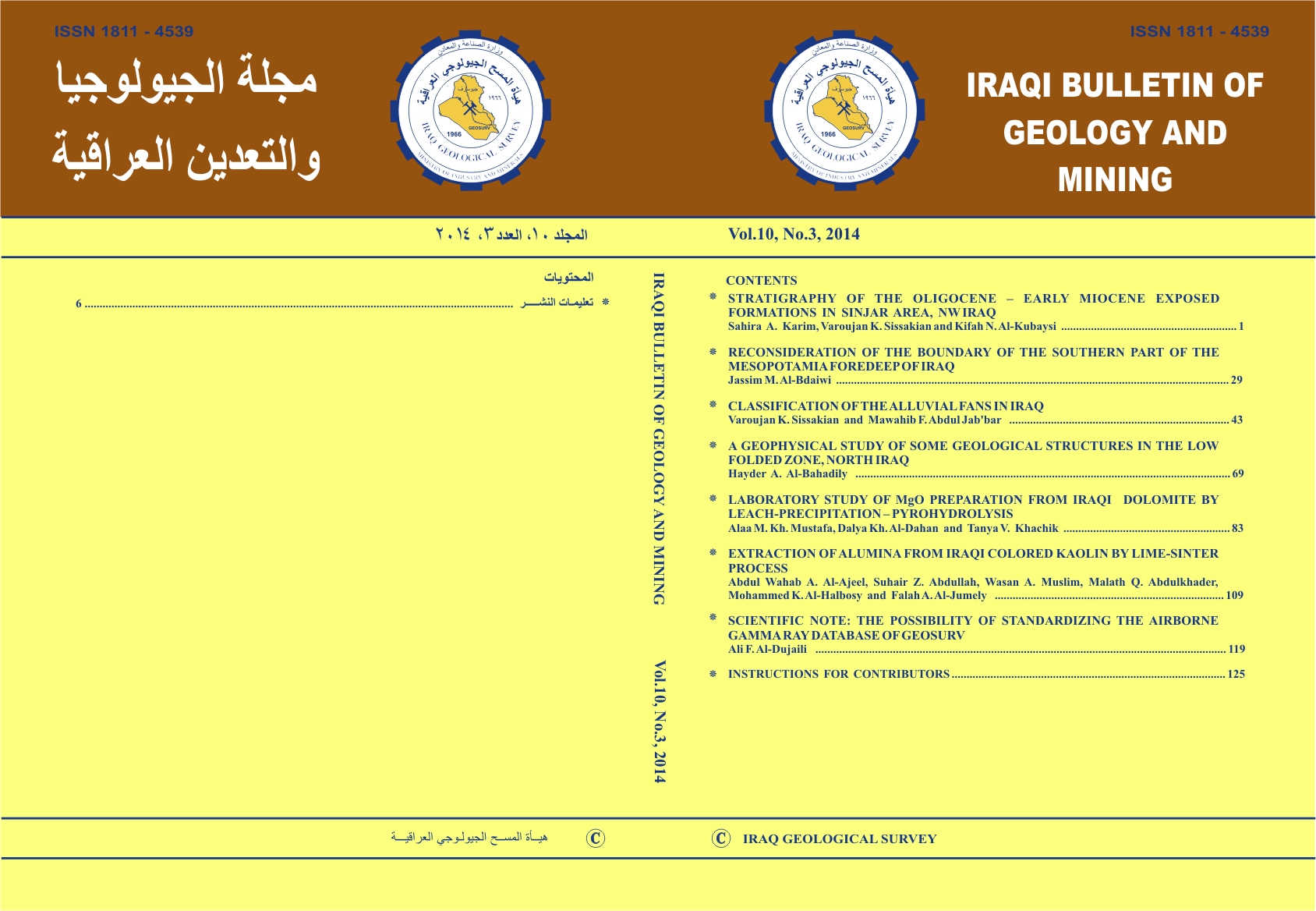Abstract
Sinjar Mountain is an outstanding structural and geomorphic feature in the northwestern part of Iraq. It forms a long anticline in which the oldest exposed rocks belong to Cretaceous age represented by Shiranish Formation. The exposed succession includes rocks of many formations, which range from Cretaceous to Late Miocene. The presence of Oligocene rocks, however, has been a matter of debate. The main aim of this study is to prove the presence or otherwise of the Oligocene formations in Sinjar anticline. To achieve that, the planktonic foraminifera of an exposed section, starting from the top of Jaddala Formation (Eocene), were utilized to interpret the biostratigraphy, and zonation of the sections.
The planktonic foraminiferal assemblages of the section were found to represent the Early Miocene (Aquitanian – Early Burdigalian) of Globigerinoides quadrilobatus primordius-Paragloborotalia kugleri Zone (N.4), Globoquadrina dihescens praedehiscens-Globoquadrina dehiscens dehiscens Zone (N.5), and Catapsydrex stainforthia-Catapsydrex disimilis Zone (N.6). Sparse fauna representing the Globigerina angulisaturalias-Paragloborotalia opima opima Zone (N.2) of Late Oligocene age, representing Ibrahim Formation, which is unconformably overlain by the Serikagni Formation. The Jeribe Formation of early Middle Miocene age of Globorotalia barisanensis Zone (N.9) overlies the Serikagni Formation; the contact is also marked by a major erosional unconformity.
The regional geology, including data from the drilled oil wells in the nearby areas, was also reviewed, in order to delineate the extension of surface and subsurface basin of the Oligocene rocks. Moreover, many recently published articles that suggest the presence of Oligocene formations in Sinjar anticline were argued and it was found that the exposed studied sections belong mainly to the Early Miocene Serikagni Formations, with presence of a few centimeters of Oligocene rocks only.
The planktonic foraminiferal assemblages of the section were found to represent the Early Miocene (Aquitanian – Early Burdigalian) of Globigerinoides quadrilobatus primordius-Paragloborotalia kugleri Zone (N.4), Globoquadrina dihescens praedehiscens-Globoquadrina dehiscens dehiscens Zone (N.5), and Catapsydrex stainforthia-Catapsydrex disimilis Zone (N.6). Sparse fauna representing the Globigerina angulisaturalias-Paragloborotalia opima opima Zone (N.2) of Late Oligocene age, representing Ibrahim Formation, which is unconformably overlain by the Serikagni Formation. The Jeribe Formation of early Middle Miocene age of Globorotalia barisanensis Zone (N.9) overlies the Serikagni Formation; the contact is also marked by a major erosional unconformity.
The regional geology, including data from the drilled oil wells in the nearby areas, was also reviewed, in order to delineate the extension of surface and subsurface basin of the Oligocene rocks. Moreover, many recently published articles that suggest the presence of Oligocene formations in Sinjar anticline were argued and it was found that the exposed studied sections belong mainly to the Early Miocene Serikagni Formations, with presence of a few centimeters of Oligocene rocks only.
Keywords
Iraq
Miocene
Oligocene
Serikagni
Sinjar
stratigraphy
Abstract
جبل سنجار ظاهرة تركيبية وجيومورفولوجية فريدة من نوعها في شمال غرب العراق ويكون طية محدبة طويلة تتكشف فيها صخور ابتداءً من عمر الطباشيري متمثلةً بتكوين الشيرانش. يضم المقطع المتكشف تكوينات جيولوجية عديدة من عمر الطباشيري والى المايوسين المتأخر. ان وجود او عدم وجود صخور عائدة لعمر الاوليگوسين هو موضوع نقاش علمي. وان الهدف الرئيسي لهذه الدراسة هو التأكد من موضوع هذا النقاش العلمي وأثبات وجود او عدم وجود صخور الاوليگوسين في جبل سنجار.لإثبات وجود أو عدم وجود صخور الاوليگوسين في منطقة سنجار، استخدمت متحجرات الفورامنيفيرا الطافية في مقطع من منطقة سنجار، شمال غرب العراق لتحديد العمر و معرفة الأنطقة الحياتية للصخور المتكشفة في المقطع المدروس وابتداءً من اعلى تكوين جدالة، من عمر الأيوسين والى أسفل تكوين الفتحة من عمر المايوسين الأوسط. أتضح ان الصخور المتكشفة ¬¬¬¬¬¬¬¬¬¬¬¬¬¬¬¬¬¬في المقطع تعود الى عمر المايوسين المبكر (Aquitanian – Burdigalian) وتحتوي على ثلاثة أنطقة حياتية، وهي من الاقدم الى الاحدث:
1 - Globigerinoides quadrilobatus primordius-Paragloborotalia kugleri Zone (N.4)
2 - Globoquadrina dihescens praedihescen Globoquadrina dihescens dihescens Zone (N.5)
3 - Catapsydrex disimilis-Catapsydrex stainforthia Zone (N.6)
كما يضم المقطع المدروس متحجرات قليلة تمثل النطاق
Globigerina angulisuturalis-Paragloborotalia opima opima Zone (No.2)
التابع لعمر الاوليگوسين المتأخر من تكوين ابراهيم المتواجد بتماس لاتوافقي مع تكوين سريگاگني. أما في الطبقات العليا فتكوين جيريبي (عمر المايوسين الأوسط) المتمثل بنطاق Globorotalia barisanensisيكون بتماس لاتوافقي مع تكوين سريگاگني.
كذلك تم مراجعة الجيولوجيا الأقليمية والأبار النفطية المحفورة في المناطق المجاورة لطية سنجار لمعرفة الأمتداد السطحي وتحت السطحي لصخور ألمايوسين و الاوليگوسين. كما تم مناقشة عدة دراسات حديثة منشورة تشير الى وجود صخور الاوليگوسين في منطقة سنجار. واكدت هذه الدراسة بان الصخور المتكشفة في طية سنجار تعود الى عمر المايوسين المبكر المتمثلة بتكوين سريگاگني مع وجود سنتمترات قليلة من صخور تعود الى عمر الأوليگوسين.
1 - Globigerinoides quadrilobatus primordius-Paragloborotalia kugleri Zone (N.4)
2 - Globoquadrina dihescens praedihescen Globoquadrina dihescens dihescens Zone (N.5)
3 - Catapsydrex disimilis-Catapsydrex stainforthia Zone (N.6)
كما يضم المقطع المدروس متحجرات قليلة تمثل النطاق
Globigerina angulisuturalis-Paragloborotalia opima opima Zone (No.2)
التابع لعمر الاوليگوسين المتأخر من تكوين ابراهيم المتواجد بتماس لاتوافقي مع تكوين سريگاگني. أما في الطبقات العليا فتكوين جيريبي (عمر المايوسين الأوسط) المتمثل بنطاق Globorotalia barisanensisيكون بتماس لاتوافقي مع تكوين سريگاگني.
كذلك تم مراجعة الجيولوجيا الأقليمية والأبار النفطية المحفورة في المناطق المجاورة لطية سنجار لمعرفة الأمتداد السطحي وتحت السطحي لصخور ألمايوسين و الاوليگوسين. كما تم مناقشة عدة دراسات حديثة منشورة تشير الى وجود صخور الاوليگوسين في منطقة سنجار. واكدت هذه الدراسة بان الصخور المتكشفة في طية سنجار تعود الى عمر المايوسين المبكر المتمثلة بتكوين سريگاگني مع وجود سنتمترات قليلة من صخور تعود الى عمر الأوليگوسين.
